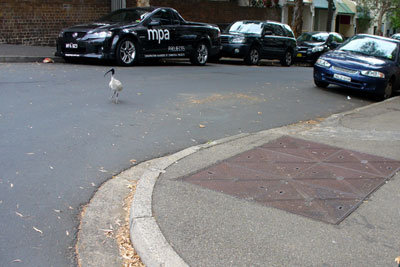In Sydney’s Angel Place, Michael Thomas Hill wants us to experience longing for nature long since lost and destroyed. His ‘Forgotten Songs’ installation charms us with its hanging bird cages and piped calls of native birds. But the sting is on the roadway where brass plaques inform us that the birds we are listening to “once sang in central Sydney, before Europeans settled and gradually forced them away”. The list of bird names inscribed there is like a wartime honour roll that we should follow along the laneway, lest we forget. The name label for the Regent Honeyeater is coincidentally positioned beside a manhole cover that, if opened up, would reveal the Tank Stream coursing beneath the lane in its modern-day guise as a stormwater pipe. Not only have trees been felled, Hill is reminding us, but the natural features of the landscape have been obliterated by the pavement itself.
But be careful what you want us to wish for, Michael. Regret the loss of charming songbirds and what do we get instead? Squadrons of honking ibis – swampland birds that have flown back from the countryside to learn the art of city living. Street smart and urban savvy, these scavengers revel in consumerism’s cast-offs.
Michael Thomas Hill’s ‘Forgotten songs’ installation belongs to a class of text-laden public artworks on the pavement that reproach us for wrongdoings past and present. I have written about these in an article called ‘Words of regret’ in Issue 3 of Sturgeon magazine, which has just hit the stands.


